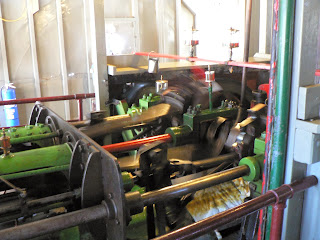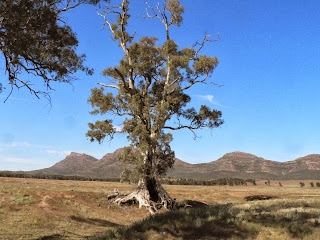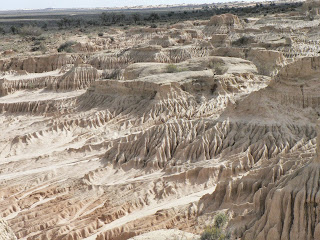Thursday, 31 Oct 2013, Echuca
We spent last Sunday and Monday morning in an around Renmark. On Sunday we walked around the town, saw the paddle steamer "Industry" at berth on the river, (unfortunately it only makes a cruise once a month), and visited the Olivewood homestead, the home of Charles Chaffey, an early settler who introduced irrigation in the Murray basin around 1880.
 |
| Olivewood Homestead |
We went out to a lookout which offered beautiful views of the Murray sneaking up and down, with a few houseboats on it.
There was a rose festival in Renmark, an annual event at this time of the year, colourful rose-bushes blossoming all around. We went into one private garden to get a glimpse of the magnificent colours and varieties of the flowers. The rest of the time we spent at our campsite at the banks of the Murray at Plush's Bend.
On Monday morning we took our caravan to a service and had a new water heater installed. This was the main reason to come to Renmark, as our old water heater started to leak under the bed and through the floor. It was not possible to repair it, which is quite disappointing after less than 2 years and no more than 7-8 months of use. It has left a big dent in our pocket but it had to be done. In the afternoon we continued our East-bound journey along the Murray Valley, passed through from South Australia to Victoria and had another nice evening campsite at the river near Merbein.
On Tuesday we went further South-East along the river, across Mildura and Hattah, and by lunchtime we stopped again at a picturesque spot along the river in the Murray-Kulkyne National Park. We spent a lazy afternon and evening there, enjoying the views and the quiet surroundings.
 |
| Our campsite at the Murray-Kulkyne NP |
 |
| Echuca - Bridge Hotel |
 |
| The Pevensey paddle-steamer |
 |
| The Pevensey - steam engine |
 |
| On the Pevensey, the Port of Echuca in the background |
Hétfo reggel elvittük a lakókocsinkat egy szervizbe ahol egy új vízmelegíto egységet raktak bele. Ez volt a fo oka hogy idejöttünk, mert a régi boilerünk már egy ideje elkezdett folyni az ágy alá és keresztül a padlón le a földre. Javítani nem lehetett, ki kellett cserélni, ami elég bosszantó kevesebb mint 2 év után, és alig 7-8 hónapi használat után. Jó sokba került, de muszáj volt megcsináltatni. Délután tovább utaztunk kelet felé, elhagytuk Dél-Ausztráliát, átértünk Victoria államba és estefelé megint a Murray folyó partján táboroztunk Merbein városka mellett.
Kedden folytattuk az utat a Murray völgyében, Mildura és Hattah után délfelé újra a Murray folyó partján táboroztunk le a Murray-Kulkyne nemzeti parkban. Itt töltöttük a délután és az éjszakát, sétáltunk a folyóparton, olvastunk, pihentünk, este megint tüzet is raktunk.
Szerdán utaztunk tovább a folyó mentén, és délután elértünk Echuca-ba, pontosabban Echuca Moama a hivatalos neve, Echuca a Murray folyó déli partján fekszik Victoria államban, Moama pedig az északi parton NSW államban. Echuca a lapátkerekes hajók fovárosa, fontos foyami kiköto volt a 19. szd-ban a vasút térnyerése elott. Ma már csak történelmi érdekesség és turista-látványosság. Jártunk it 1996-ban a gyerekekkel együtt, de csak éppen körülnéztünk, és akkor eléggé szomorú látványt nyújtott a kikötoben látható néhány félig vízbe-merült hajóroncs. Most egy egész flotta szépen restaurált gozös áll a kikötoben s az egész város sokat feljodött. Sajnos a régi kiköto nagy része még mindig felujítás alatt áll, de a foutca jól néz ki a régi üzletek és pub-ok cégtábláival.
Ma (csütörtök) délelott a fo program egy sétahajózás volt a Pevensey nevu lapátkerekesen. A Pevensey az egyik legrégebbi gozös, 1982-ben egy ausztrál TV-sorozatban Philadelphia néven szerepelt. Egy órát lapátoltunk fel-le a folyón, gyönyöru tiszta napsütésben, több másik gozössel együtt, láthatóan népszeru idotöltés ez a magunkfajta turistáknak és iskolai kiránduló csoportoknak. Beszállás elott a kikötoben is jobban körül tudtunk nézni a ma múzeumként muködo régi raktárak és daruk között.
















































